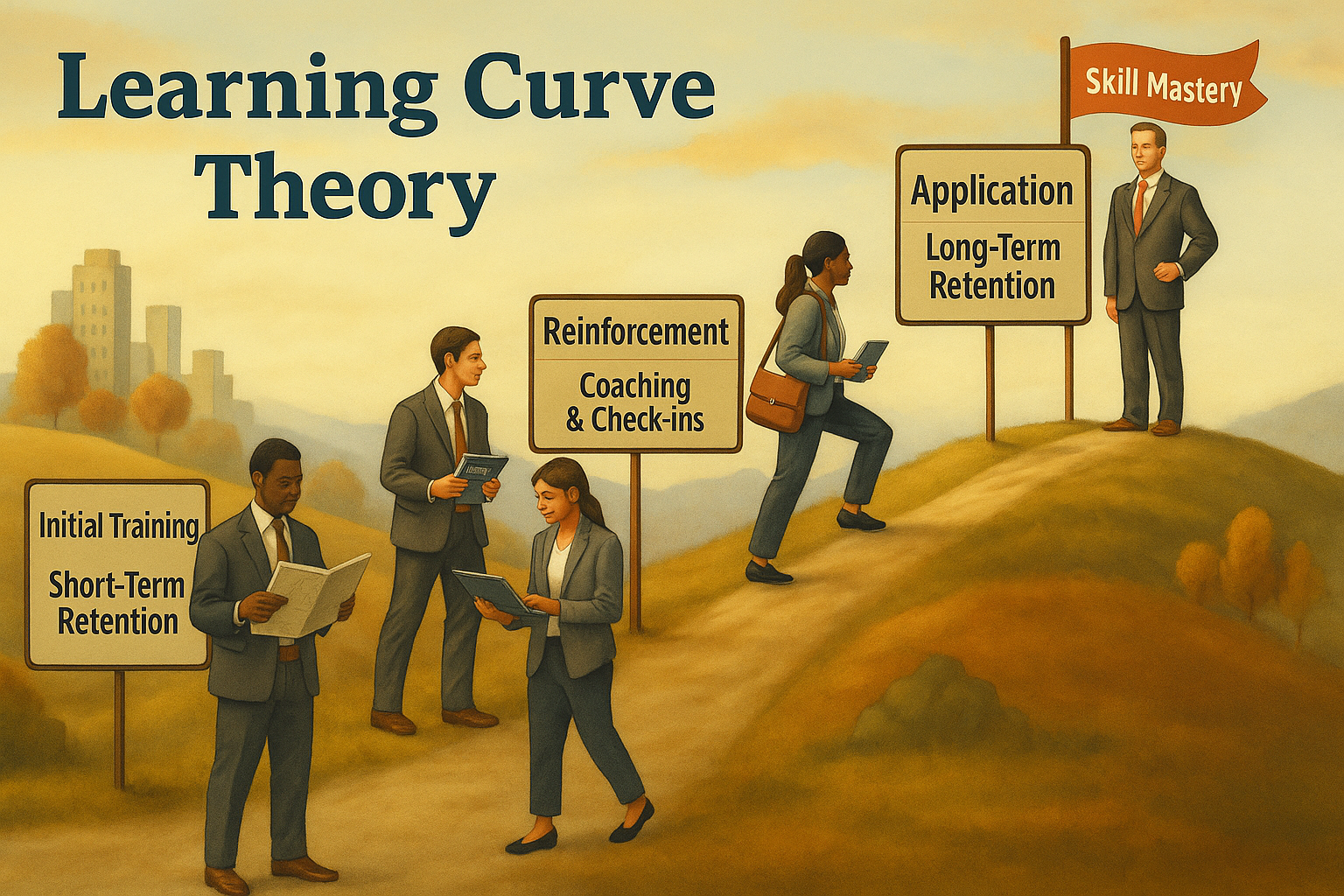
Imagine we’re gathered around a round table—coffee mugs steaming, notepads open, and the occasional chuckle breaking the hum of serious conversation. You’re a leader in your organization, and someone mentions the “learning curve theory.” Heads nod politely, but what does that really mean for your team’s training effectiveness and long-term retention? Let’s unpack it together—without jargon overload, cheesy analogies, or bullet-point boredom.
At its core, the learning curve theory is a roadmap of how people improve over time. Picture it: first attempts are slow, mistakes happen, and confidence is measured in baby steps. With practice, performance accelerates. Historically rooted in industrial settings—think assembly lines—the learning curve now applies just as well to digital classrooms, professional workshops, or virtual training sessions. In a corporate environment, it gives us realistic expectations about how quickly new skills are acquired, from mastering a software platform to managing intricate client relationships.
When leadership understands this learning curve theory, magic can happen.
First, expectations align. If everyone expects instant mastery after a two-day webinar, disappointment looms. If leaders say, “We’re going to build momentum over months,” suddenly the training journey feels credible—not magical. Plus, it makes measuring training impact easier. Instead of asking, “Did everyone ace it?” you ask, “How steep is our curve, and how can we optimize it?”
Short-Term Retention refers to the immediate grasp of information following training.
In this phase, learners may ace their post-training quizzes or demonstrate competence in hands-on activities. It’s encouraging, but also fleeting. Without reinforcement, this fresh knowledge can fade quickly—through no fault of the learner. The learning curve theory predicts this drop-off. It’s a natural dip that shouldn’t trigger panic but instead inspire planned support.
Long-Term Retention is where the learning curve becomes most valuable. For knowledge and skills to stick, learners need more than exposure—they need repetition and context.
That’s where post-training reinforcements like coaching, peer discussions, refresher training content, and practical application come into play. When integrated smartly, these tools help learners move past the fragile early phase into true mastery, turning new habits into lasting performance improvements.
Around the table, leaders often ask: “How long before we see results?” Good question. The answer? It depends.
Skill complexity, learner background, training quality, and follow-up support all shape that curve. Simple tasks might show progress in weeks. Complex behaviors—like mastering leadership styles or technical troubleshooting—could take months. The key is to avoid micromanaging the curve. Instead, track and celebrate incremental improvements, especially early on, when progress might feel slow. Those early accomplishments build confidence and positive learning momentum.
So, how do we translate that theory into strategies with real training impact?
Start with a sound training design. Great content introduces core concepts clearly and gives participants time and space to practice. Real, meaningful practice. Rather than reviewing PowerPoint after PowerPoint, learners engage in simulations or real-world scenarios that mirror their day-to-day roles.
Next, build in follow-up. It might be quick refresher training videos delivered via email or 15-minute cohort check-ins to share challenges and insights. Even simple peer-mentoring networks can make a huge difference. These follow-ups reintroduce learning and gently push the curve upward.
Leaders can also adjust workloads and timelines. If a team is being asked to implement new tools immediately after training, that can flatten the curve—frustration sets in and motivation dips. A better approach: embed new skills gradually. That might mean intentionally pacing implementation over a quarter instead of a week, giving learners time to assimilate and improve.
Training impact metrics shouldn’t just measure whether employees completed a class. Instead, layer in broader indicators: errors reduced, productivity gains, client satisfaction, or employee confidence. Early-stage metrics might focus on completion and quiz scores, but middle and later phases should look at real-world outputs. Tie those outputs to training milestones and you’ll see the curve in action—slow climbing at first, then a steeper ascent as the team internalizes their learning.
If you notice a dip or plateau, that’s not failure—it’s a signal. It tells you to inject more support: maybe a coaching session, a refresher training module, or a group discussion. The learning curve adapts depending on how your organization responds.
I once worked with a client implementing a new project management platform. We held a week-long training, and leadership checked in a month later expecting polished results. Slides were slick and participation was high, but when we looked at real usage, people were flailing. The learning curve had barely begun.
Instead of scrambling, we introduced bite-size support: weekly drop-in clinics, “how did you handle that?” group discussions, and follow-up quizzes. We shifted expectations, explaining that deeper adoption often takes two to three months. People appreciated the honesty, and adoption rates increased steadily. By month three, it was clear: short-term retention got everyone started, but long-term retention and skill mastery required reinforcement—and realistic expectations. The learning curve that at first seemed slow became a steady climb.
Think of the learning curve as your invisible ally—it’s not a barrier, but a guide. When drafting training plans, invite leaders to consider:
Now is the moment to act.
Revisit your recent training programs. Measure short-term quiz results. Observe day-to-day performance. Notice where learners plateau or gain momentum. Then design or refine your scaffold of support—be it automated refreshers, skill clinics, or peer mentoring.
If you’d like help measuring the curve or creating training that drives tangible business impact, the LatitudeLearning team is ready to partner with you. We specialize in transforming thought leadership into real-world learning effectiveness.
Let’s shape your learning curve together—and make training really count.